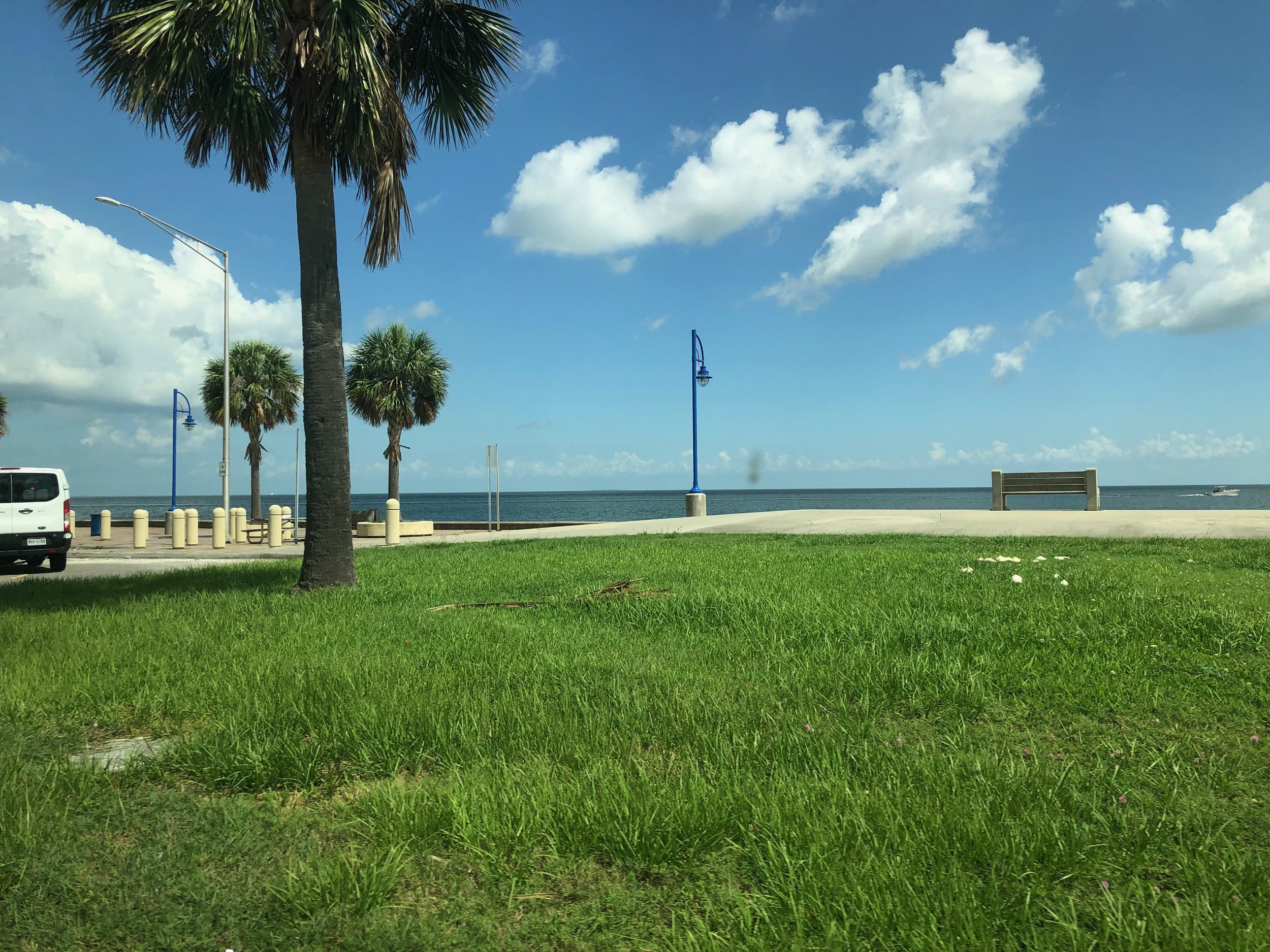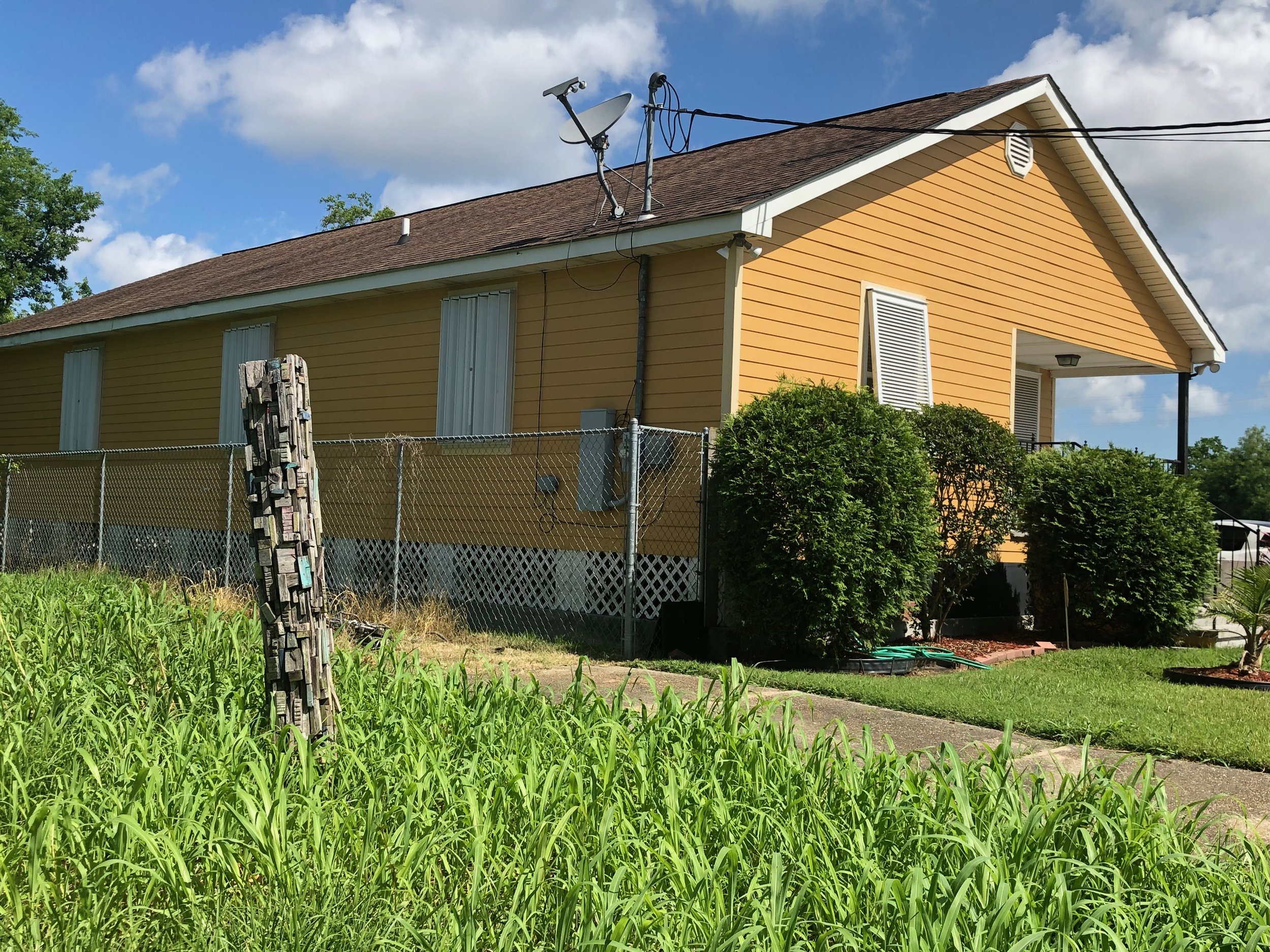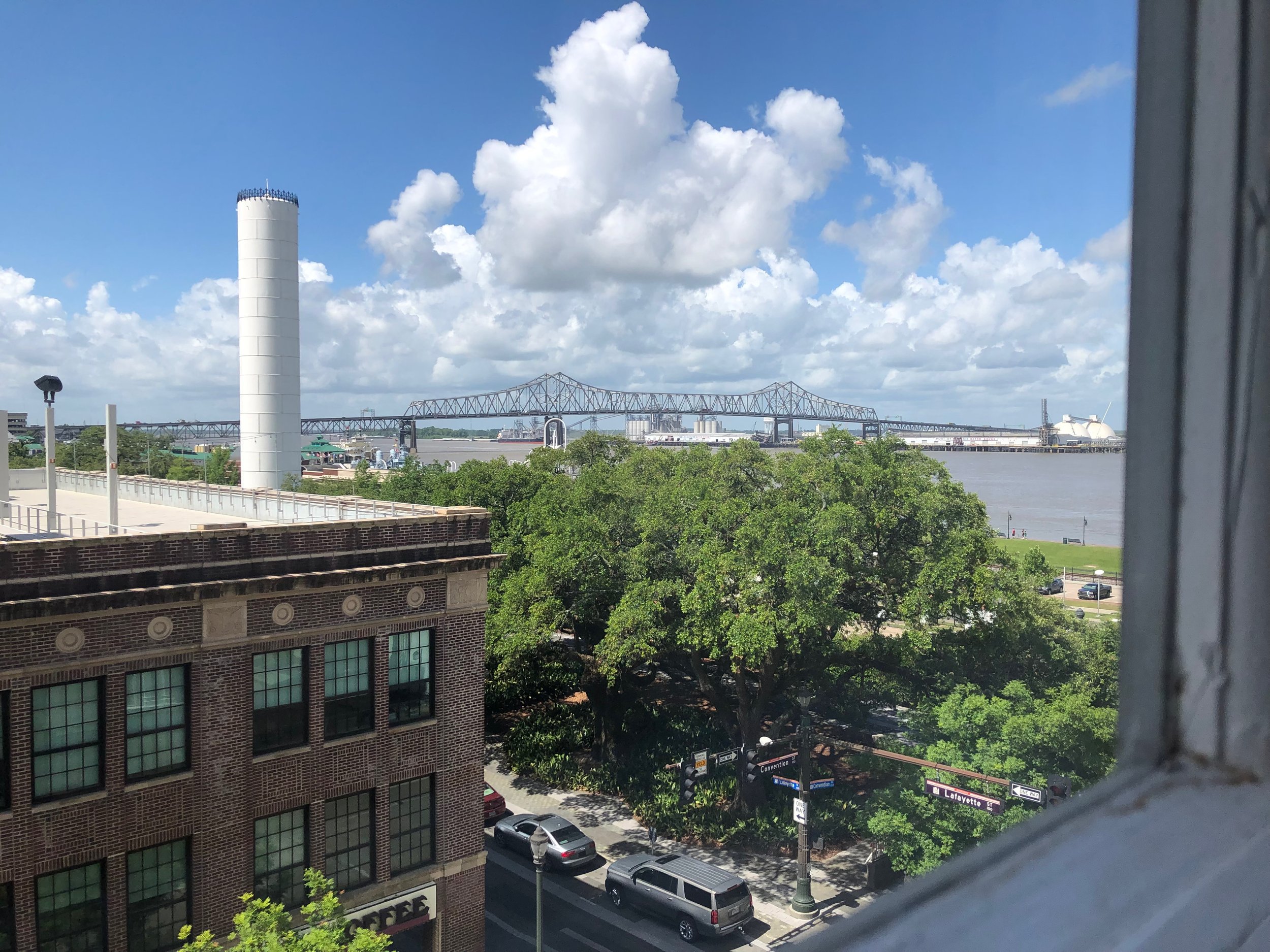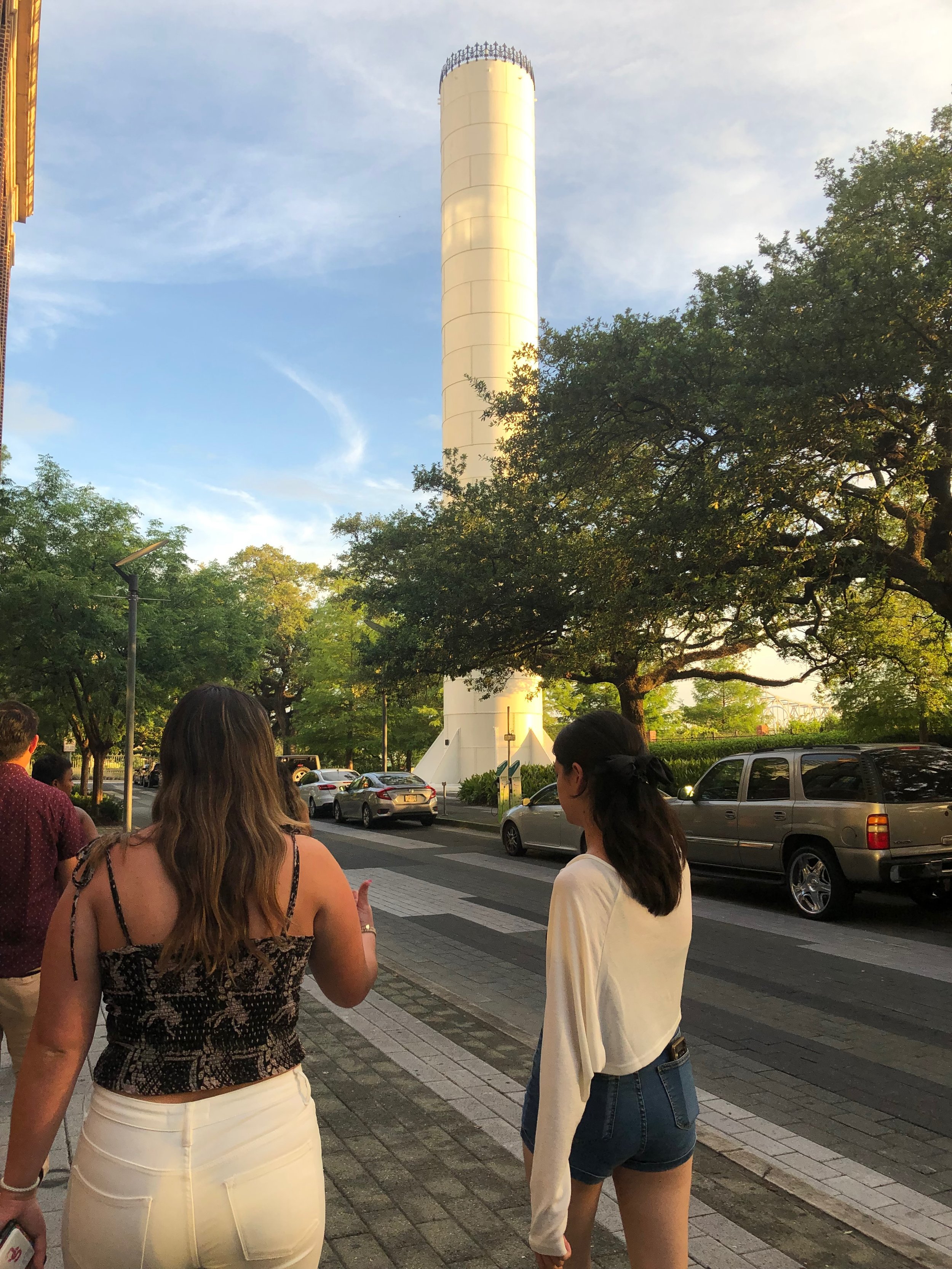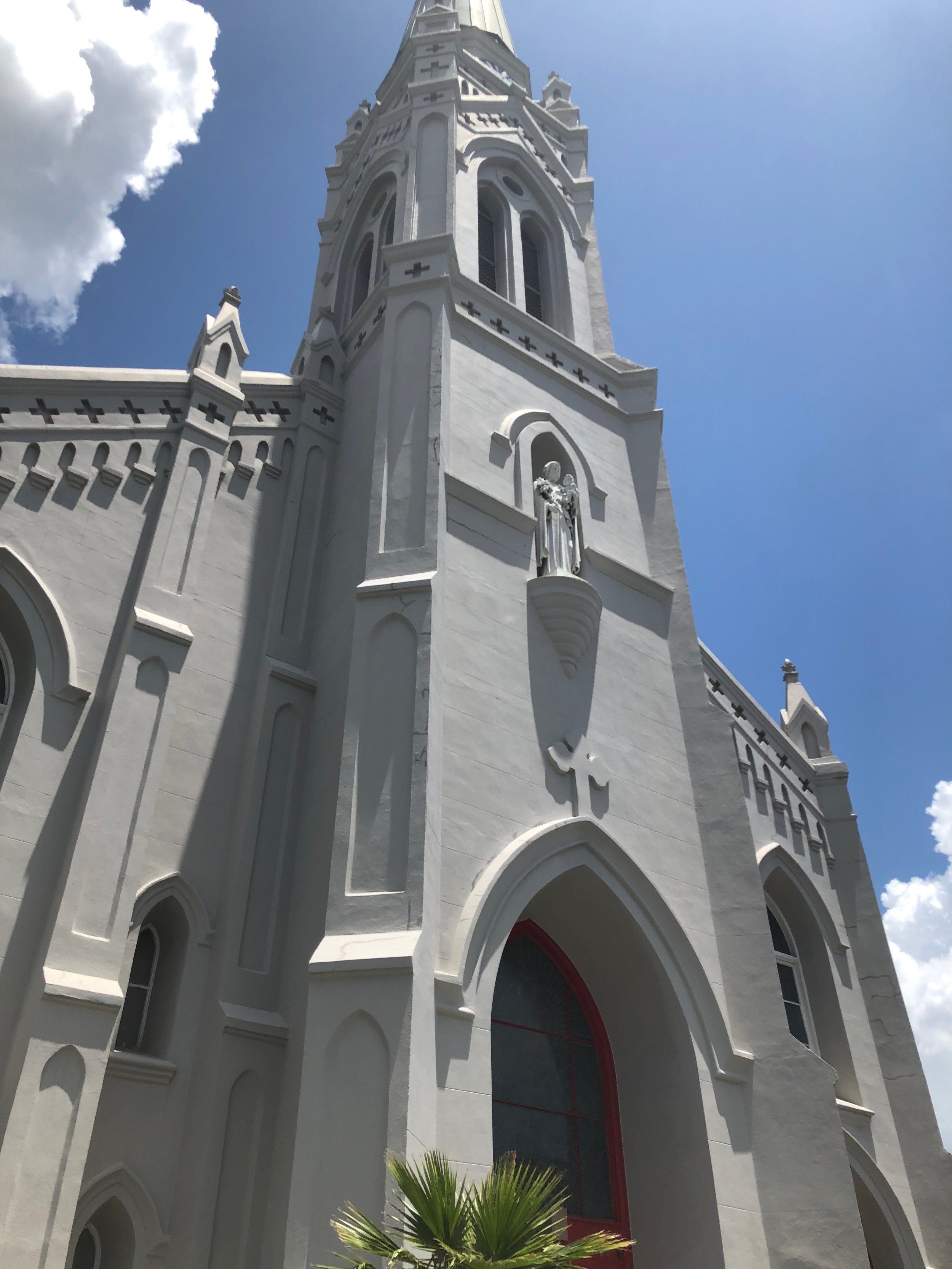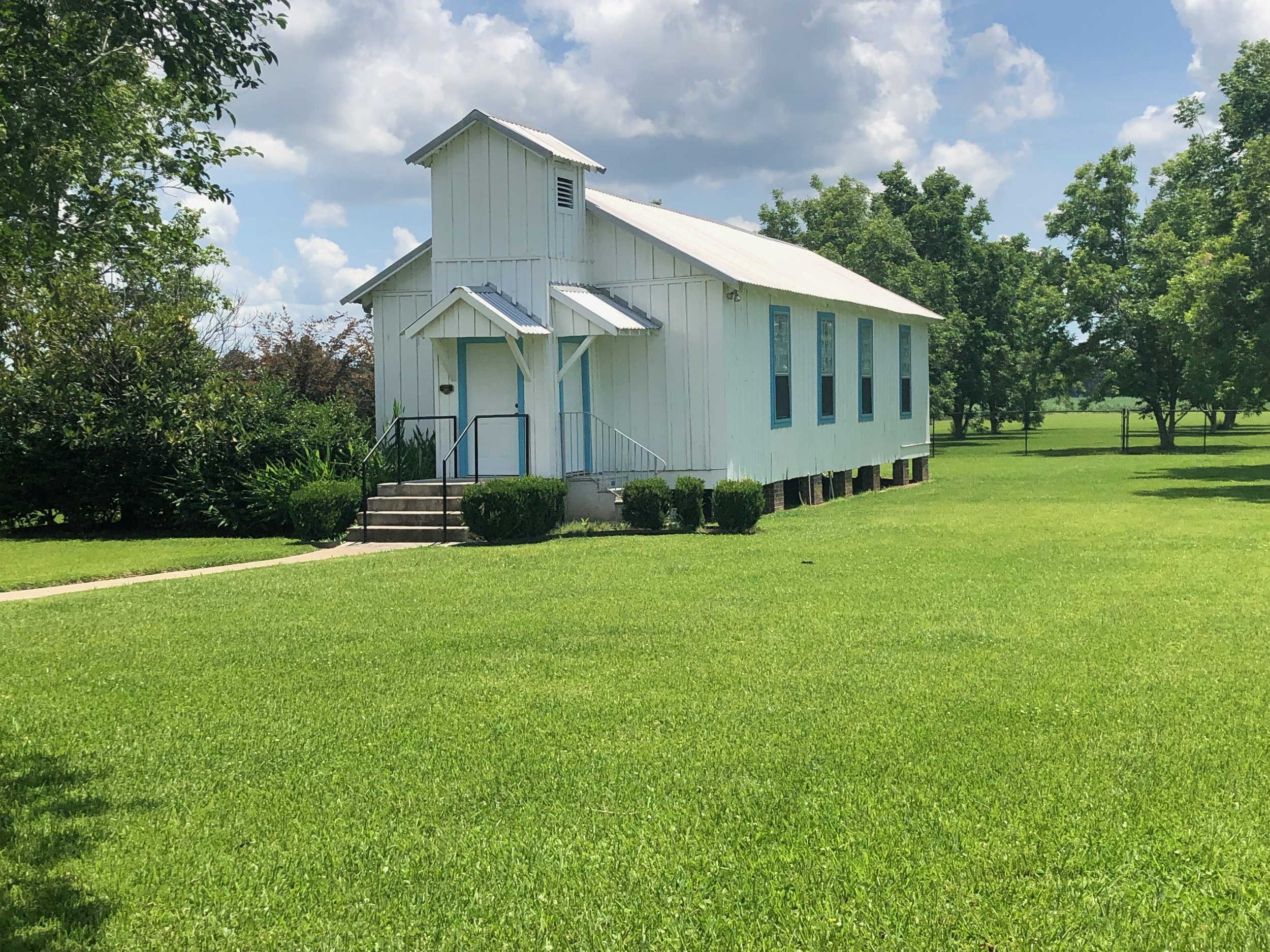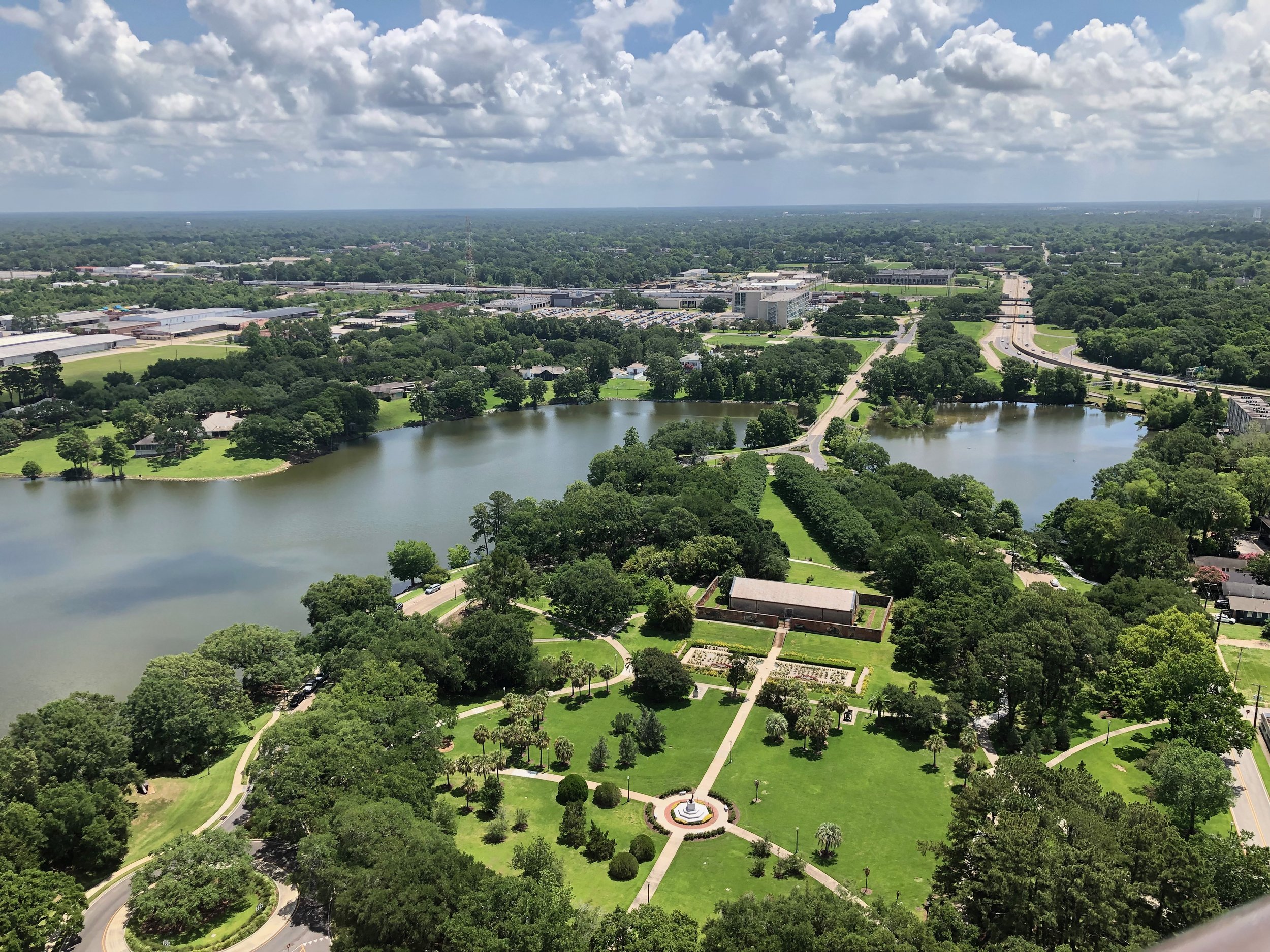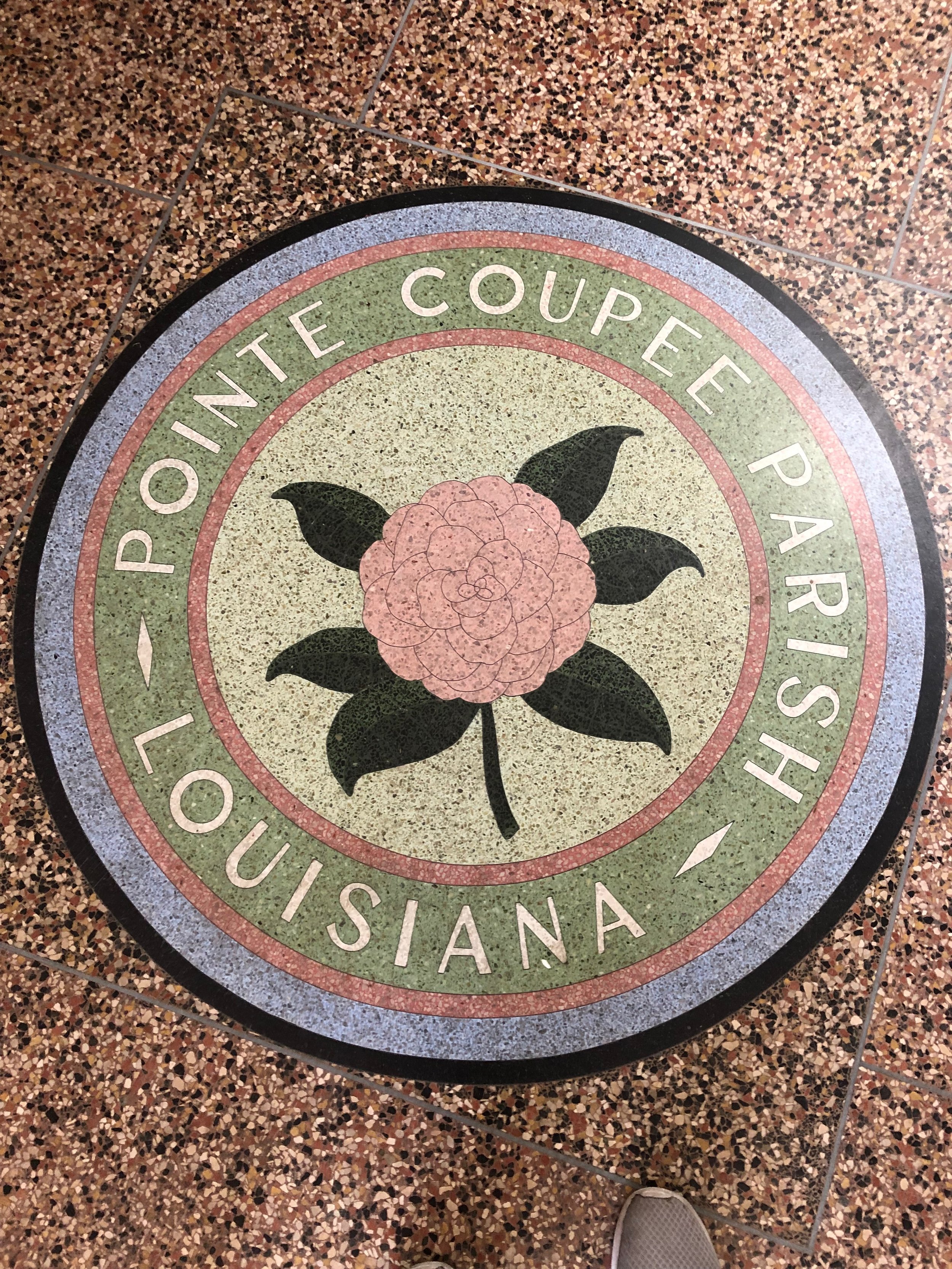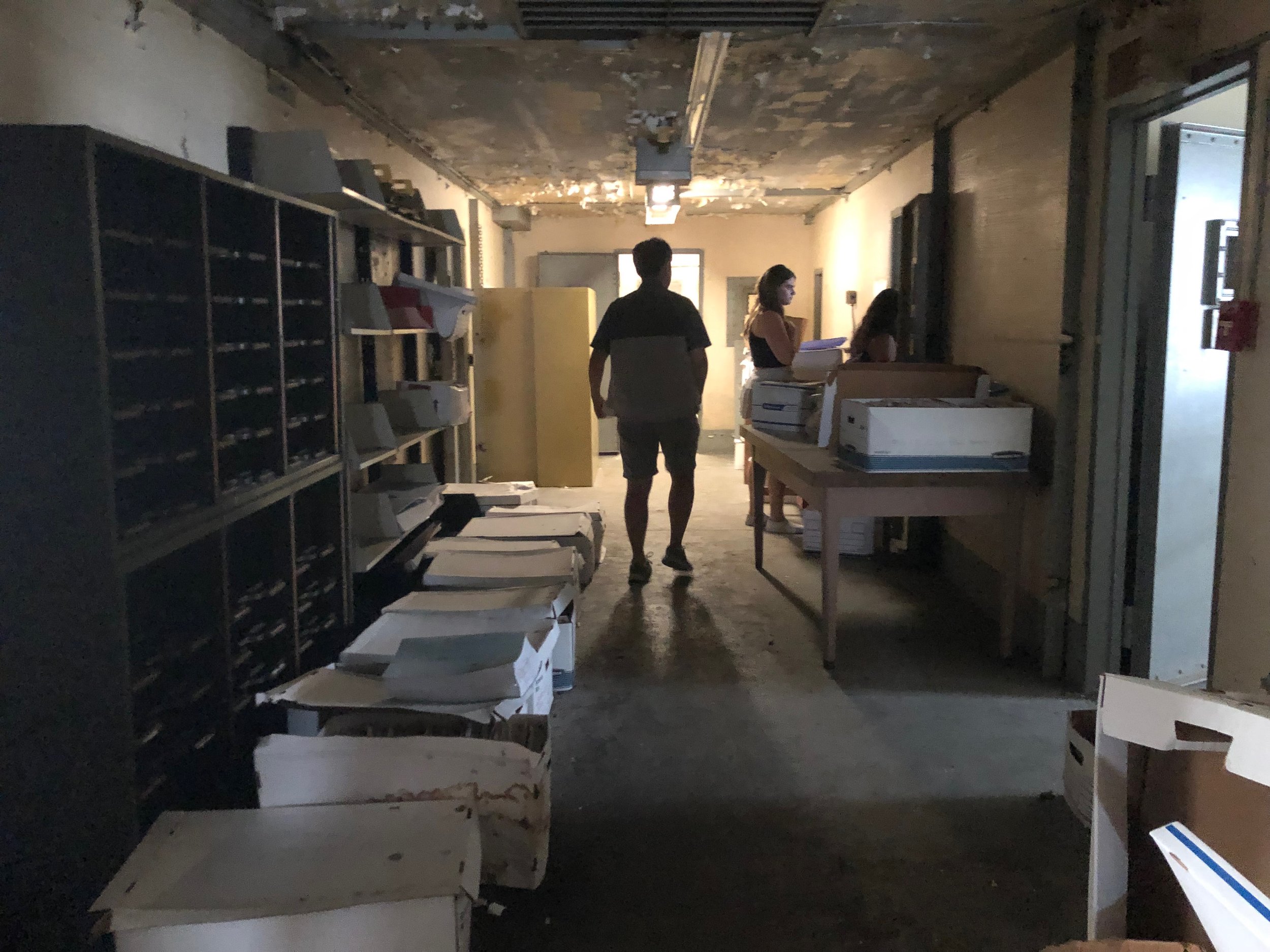In our attempt to flee the luring neon lights and boisterous crowds of the Big Easy, we briefly made a stop in the Lower Ninth Ward to examine the reconstruction efforts of the town. This town held a special place in my heart; it was where most of my family members from my mom’s side were born and raised. Ever since I was a kid, I always wanted to learn more about myself and where I came from. As time went on, these interests slowly faded and were replaced with the general obligations of life. Truly, this Maymester has re-ignited a burning desire in me to continue on this historical and personal search for my original community. While the semi-reunion was spiritually lifting, the heart was not in a soft spot. The Ward – and areas just like it –was severely damaged by Hurricane Katrina. What me and the gang were seeing now was just a fraction of the reconstruction process. Part of the rebuilding efforts were made possible by a non-profit called the Make it Right Foundation. The foundation, initiated by Brad Pitt, is responsible for constructing over a hundred houses. While several sources may point out some of the damages brought on by the non-profit (e.g. cheap materials, faulty electrical, plumbing), no one could take away the fact that someone was at least trying to make a difference. At a time when the South’s inhabitants felt left behind, someone was willing to pick up the pieces of debris and hold the hammer. A town rebuilding from the ground, not just through the lavish donations of celebrities, but through the strong will of the locals. Migration did not prove to be the answer, and we will get to that topic a bit later as this significant event in history also holds a special place in my family’s legacy.
The Lower Ninth was the first of many steppingstones for our next novel. Written by Ernest J. Gaines, A Lesson Before Dying is a fictional recreation of the 1940s South when segregation was the new normal and racially driven policy could roam free without check and balance. The story is about a young Black man named Jefferson – in real life, his name was Willie Francis – who gets caught in a liquor store shootout and is unfairly sentenced to death by electrocution. The court system failed Jefferson – and even worse – convincing him that he was lesser than a human being. Emma, Jefferson’s godmother, has one request for her boy on his last day on earth: to stand up and become a man. From her perspective, if Jefferson cannot fulfill this task, then there will not be another soul brave enough to break the cycle of racial oppression that feeds off of their town. In his cell, Jefferson not only holds the key to his sanity but also the burden of the community, that which has been passed down for the past few centuries. And it will take a lot more than the iron bars and fellow inmates for him to reach his destiny.
“I could look at the smoke rising from each chimney or I could look at the rusted tin roof of each house, and I could tell the lives that went on in each one of them.”
My first days in Baton Rouge left a big impression on me. A quiet, humble, downtown metropolis filled to the brim with national landmarks and accompanied by a voluptuous river which I could see no ending for in either direction. Living all my life in the bustling streets of Los Angeles, I never thought I would ever be saying these words in the same sentence. The place that Jefferson finds himself incarcerated is called Bayonne. Featuring 3500 whites and 2500 Blacks, this town offered an amenity and institution for each race. Ranging from separate churches to separate movie theaters, it was like a tale of two cities enclosed in one. This division paints the picture for what kind of society – or rather societies – that are at the throats of each other. On one side, we have a dignified and courteous white society that has been blessed with exceptional educational institutions and a sufficient number of recreational establishments and facilities. And on the other, a Black community which must live off the sweat of their labor and cannot afford just the right amount of ice cream. Bayonne is a representation of just how impactful skin color can be on the wellbeing of an individual during these decades, and how those long-term side effects have bled into modern day society. After settling into our hotel, me and some of the group went on a mini scavenging hunt in search of some goods to devour for the long night ahead of us. Food options were scarce and to be desired, but this was not what we came here for. Rather, the gang and I sought to feed our very souls with the greetings and kindness of the hospitable town folk.
Look, an oversized chimney!
Matherne’s Market
We stopped by Matherne’s Market, where the sushi was still fresh and a bank vault was itching to be opened. (If you don’t believe me, just ask Dwayne Johnson). At the checkout aisle, the cashier lady bombarded me with “sir’s.” In my counterattack, I referred to her as “mam.” Before going on this trip, I was told by my friends that this was a custom that Southerners could not live without. According to Google, these name placements are shown to be a sign of respect and political address. I didn’t buy this for a single second, and neither does my mom who always hated hearing those words in her early childhood days. For me, these two words – while they do invite courteous behavior – can also bring in a form of classification. Essentially, you are forced into a category from which you must uphold or else risk losing status or dignity with that person you are conversing with. As witnessed by Grant – a teacher and friend of Jefferson – it digs into your very identity. In order to “play his part” with the sheriff of the town, Grant must always address Guidry with “sir” or else risk being looked at as an undesired Black. This moment really frustrated me because you can’t be anything but what that other person tells you to be, and I don’t plan on bringing this formality back to my own hometown. The cashier lady was super nice, but the language her city stuck to did not give off welcoming intentions.
“You’ll leave your church and just become – nothing?”
Over the course of Jefferson’s mental journey, he is battling the very faith that promises to bring people together. Gaines has placed religion as a central piece to the book; in Downtown Baton Rouge, religious monuments are not shied away from the public. I cannot tell you the history or even the names behind the churches and chapels our group crossed paths with, but I can say that they did stick out from the corporate offices. From Gaines’s eyes, religion is an other-worldly power that can rally the Black community at a time in history when education and illiteracy rates were at their lowest. For Tante Lou, Grant’s aunt, being Catholic means everything for a lady of quality, it is mixed into one’s identity. In her discussion with Vivian, Grant’s girlfriend, Lou is displeased after hearing about Vivian’s possible church transfer. Even if you take your religious practice elsewhere, your faith will not be impacted the same as it was with the presence of your community. For Vivian, moving out of town with Grant could mean the possibility of breaking away with her Catholic roots and losing her faith over time.
While there is some peace to be found in the religious garbs, being Catholic in this book is seen as a double-edged sword. On one end, Grant paints religion with this kind and merciful image through the viewing of Emma. Emma, who has lost her godson (Jefferson) to the discriminatory court system, finds a new “Master” to worship. God is the new leader for whom she will take the commands and guidance in the hope that it will spiritually bring back her boy. On the other end, people like Reverend Ambrose are using religion to deliberately lie to followers in the hopes that it will bring them joy and comfort. In fact, Ambrose explicitly tells Grant that he needs Jefferson to kneel before he can stand, fearing that the boy’s soul will be lost in hell. This action is not only meant to bring comfort to Jefferson, but also comfort to those like Emma who are looking for a way to relieve the pain that they endure from their white counterparts. Although there are good motives behind the lie, there are moments when religion can be abused for the sole purpose of benefitting a single party. In other words, slave owners can further exploit slaves by promising a heaven for their persistent hard labor. As seen by Jefferson, there is no racial union on the subject of God. The Lord only serves the interests of white folk and ignores the Black community in times of need. Visiting the Gaines’s estate near the False River was a truly unique experience; we were able to look inside a small church originally built in the 1930s, where Gaines used to receive lessons as a kid. Going into the church and observing the wooden benches which also served as student desks…I was brought back into the story, thinking about Grant’s teaching situation; a man – similar to Gaines – with a wavering faith, but still educating the next contributing members of the community while under the house of God…powerful.
Every man a king, but no man wears the crown
〰️
Every man a king, but no man wears the crown 〰️
On a Tuesday, me and the gang went to visit the Louisiana State Capitol (the new one, not the old). The structure was built with just two years, a deadline unheard of in the political sphere of construction. This feat was made possible by the ambitions of one of the most inspirational political leaders of the South’s time: Huey P. Long. You can also call him Kingfish if that floats your ferry. Serving as Louisiana’s state Governor, Huey worked for his community, and the people willingly gave him the power and votes needed for immense reform such as building more roads and expanding medical and educational institutions. To put this in perspective, the Great Depression was rampant among the 1930s. The South’s people at this time found itself in this state of economic abandonment. And Huey – receiving the governor position in 1928 – was there to hold up the torch, to become a champion of the common man who could lead the community back on the route of progress. During his quest to crush the elites of his state, Huey introduced Share Our Wealth, a program designed to lower personal fortunes and give those impoverished Americans a monetary boost via annual grants. Regardless of the accomplishments brought on by the Long Administration, the change would not be enough to keep some of the Black communities in the South. A new life was sought after, preferably one with more palm trees and beaches as far as the West Coast stretched.
With the weakening rate of employment and desire for financial advancement, The Great Migration marked a turning point for African Americans across the South. This transition from rural to urban city living was not just predicated on changing economic circumstances, but to escape the divided racial landscape of the South. Grant is never shy in telling Vivian about his wish to leave for California, where his parents are staying. However, there is one ironic element that is keeping them from making the escape: family. Vivian has to think about her children and how they would be losing the values and people they are growing up with in the quarter. For Grant, he is only fixated on advancing his career, even if that new job promises to better the lives of his family. Additionally, if the two leave now, they jeopardize the love and connection with other members of their community like Emma and Tante Lou. After migrating out of the Lower Ninth, my relatives also looked to California as the beacon of change, well, two beacons. The first one was located southwest of Downtown Los Angeles in a city called Crenshaw, while the other – a little more well-known – was Oakland. Crenshaw was a town in which I could easily visit my aunts and uncles and still feel a connection with the Creole underbelly of Louisiana. Originally a Japanese community after World War II (this is very evident in some of the exterior of the homes if you ever decide to stop by), this neighborhood now boasted a strong Black population. Despite the immediate benefits of the Great Migration, there would still be hurdles for minority groups to face, two of the largest being redlining and eventually gentrification. Between these two evils, redlining was special in that it pushes people out of a potential home via discriminatory practices, resulting in a chain reaction of issues that can range from literacy rates to even crime rates. Through these harsh realities, a community of brave Black souls, young and old, from all corners of the deep South found a way to thrive in another foreign land, together as if they were family members coming back to a reunion.
“I had heard the same carols all my life, seen the same little play, with the same mistakes in grammar…. Next year it would be the same and the year after that, the same again. Vivian said things were changing. But where were they changing?”
The lesson on community is at its climax during the last hours of Jefferson. During these final breaths, Jefferson is not only receiving gifts from his godmother, but also from various neighbors (e.g. pecans from school children and the radio bought using several monetary donations). As mentioned in our seminar, it can be quite hard to accept that receipt of love from others. Slowly, through the vision of Emma’s cooking, Jefferson accepts her gumbo and accepts his place back in the neighborhood. These gifts of giving can be viewed at as Jefferson’s own fair trial by peers, a trial which he never received during his prior sentencing. As depicted by Grant, this was a court system which relied on “Twelve white men [saying] a black man must die, and another white man [setting] the date and time without consulting one black person.” Despite this, the quarter recognizes Jefferson for who he really is: a man of their community. He is not a hog that gets force-fed the cruel power of white town members; he is a human being who represents the change in mindset that Gaines wants for Southern society.
Our group was honored to visit the cells and courthouse at Point Coupée (New Roads) Parish. In the courthouse, we met several significant figures of the local town, including the mayor and Sheriff Thibodeaux. Their views on community policing really struck me; this small conservative town understood the importance of this concept, and yet progressive cities like Los Angeles will struggle with its implementation.
The last parts of the tour involved visiting the courthouse and jail. In these cells, I thought about how Jefferson was feeling, how he got to his mental state…but also how he prevailed when all there was to see were iron bars and ice-cold floors. Was it his renewal in faith that brought his spirit back? Or rather, was it the loving members of his community who reminded him of what his true identity was before the corrupt policing system? As the past lingers, a community’s inhabitants must continue to stand up if they seek to protect their future for the next generations. Racism is one of those things that cannot be whisked away through the stroke of a chalk piece on a board. It has to be confronted, but not alone.

